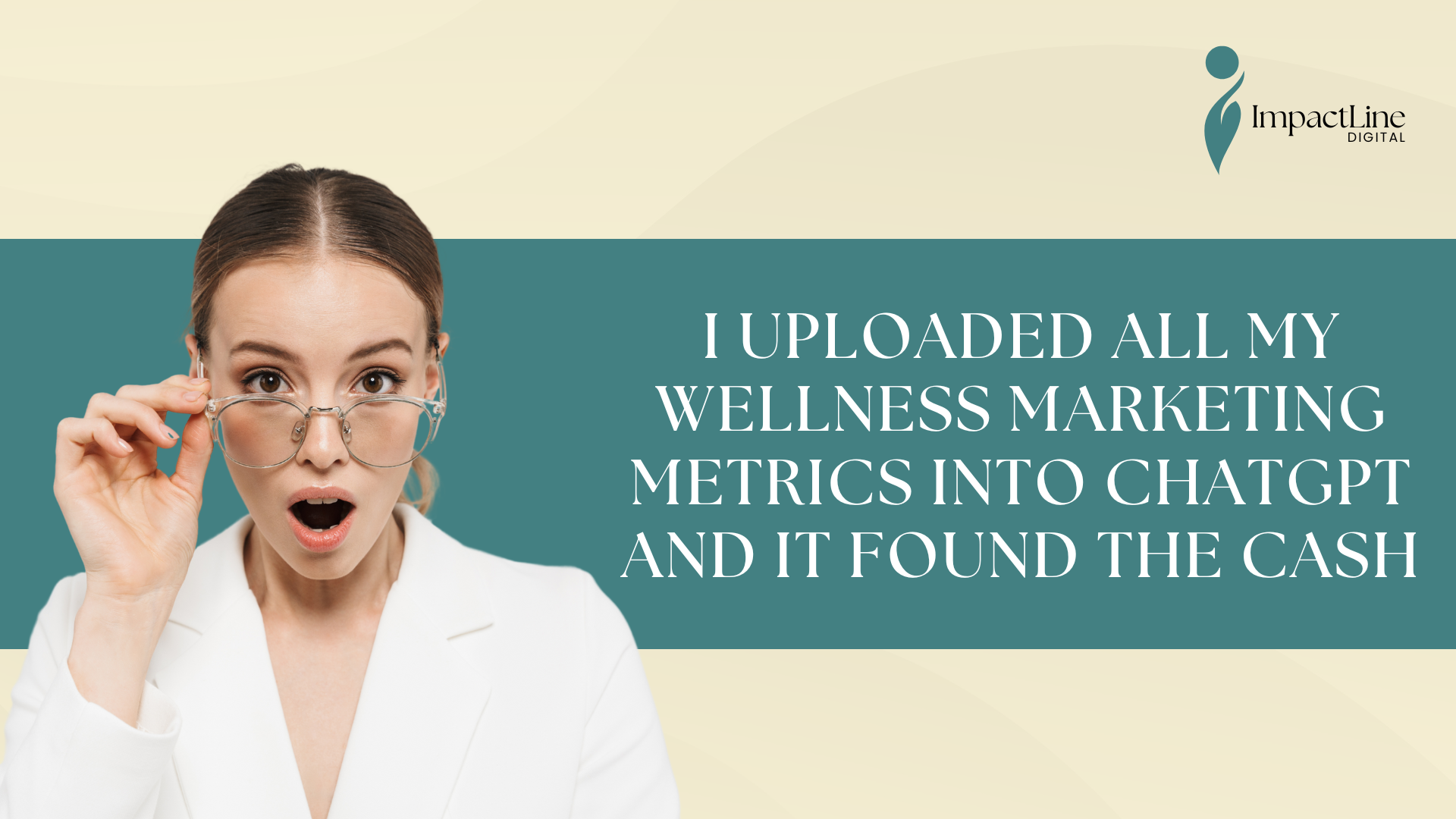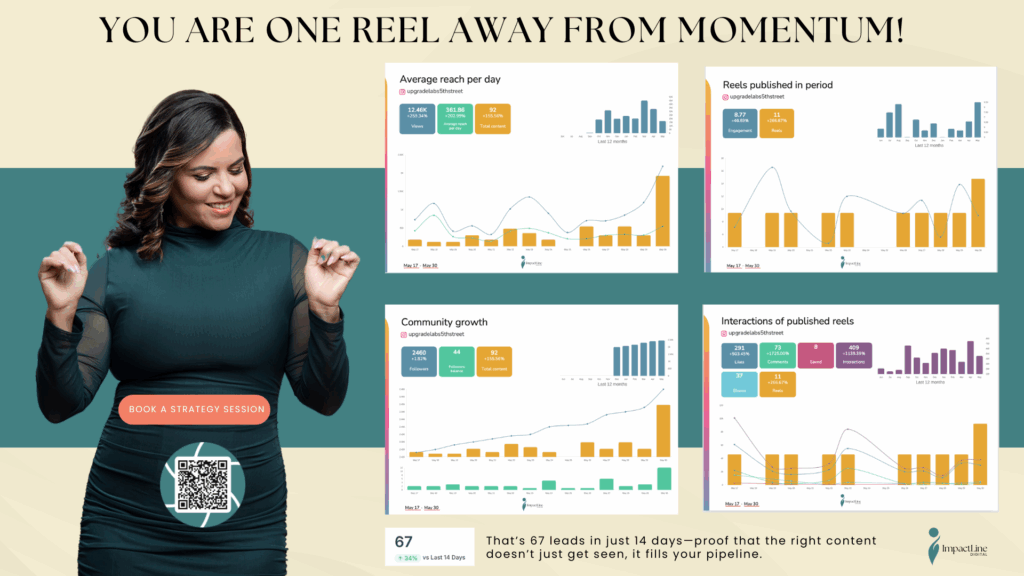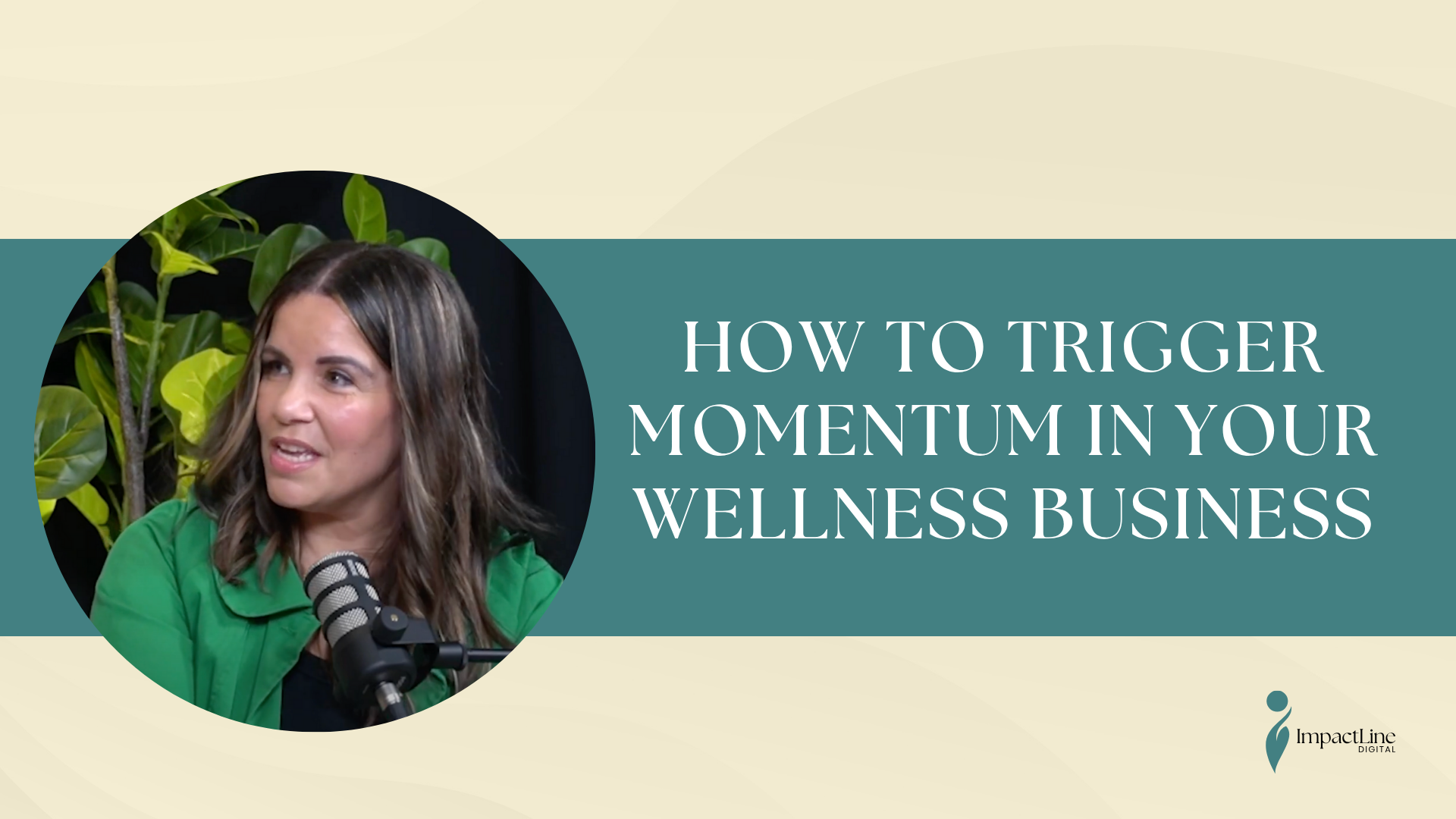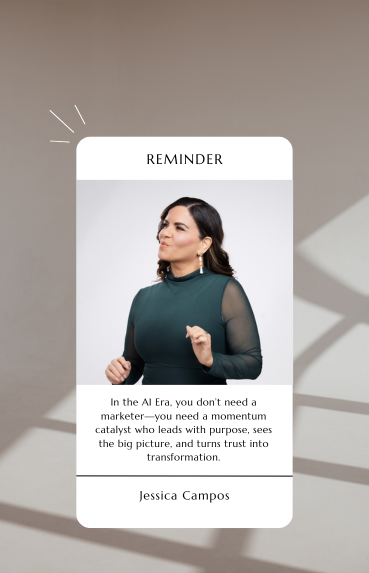
I Uploaded All My Wellness Marketing Metrics Into ChatGPT—And We Found The Path To Cash
We’re about to enter the final month of Q2—and in our world of performance marketing (or as we call it, growth marketing), that means it’s time to pause, analyze your goals, and decide what gets your energy next.
So I did what I always do in seasons like this: I opened up the dashboards, printed the client reports, and stared at a dozen Eventbrite surveys blinking at me like they had something urgent to say. I’ve been deep in strategy mode—searching not just for patterns, but for meaning.
We all talk about data. But let’s be honest: most people collect metrics and never extract insight. That’s where I like to go deeper.
Years ago, I branded myself The Forensic Marketer—not because it sounded cool, but because I believe numbers should tell a story. A story that informs your next move.
So this week, I ran some of my forensic frames with AI.
How to Use ChatGPT for Forensic Marketing (and Actually Get Insights)
Most people use ChatGPT to write content. That’s fine. But if you stop there, you’re missing its real power.
Writing content with AI good. But finding what content is driving conversion, in my opinion, it’s the real goal from content marketing and social media marketing.
Here’s how you can analyze your content marketing performance:
- Gather Your Data
Export your reports from the tools you use—Google Business, CRM, social media, website analytics, and event platforms like Eventbrite. - Organize It by Channel
For example:- Instagram Reels performance
- Google call volume
- CRM lead sources and conversion paths
- Event attendance and feedback
- Monthly sales totals
- Upload to ChatGPT
Ask smart questions like:- “What trends do you see in lead-to-sale conversion rates?”
- “What’s the strongest first-touch platform?”
- “What channel drives the highest-quality leads?”
- “What’s the optimal number of touchpoints based on conversion lag?”
Pro Tip: Use Metricool to Centralize Your Marketing Data
I use Metricool in our agency to pull all these reports into one place. Instead of juggling multiple dashboards, I get one clean view of:
- Social media performance
- Website traffic and behavior
- Google Business profile activity
- Paid ads
If you’re trying to connect dots across your marketing and sales, Metricool is a game-changer. I use it with every client, and it saves us hours every week.
Try it here → (Yes, affiliate link. No, I wouldn’t recommend it if I didn’t trust it with my own agency.)
Professional marketers don’t rely on Instagram Insights—because real growth isn’t measured in likes. It’s measured in behavior, patterns, conversions, and momentum. It’s not just a skill—it’s a six-figure role in leading companies for a reason. When you hire an expert, you’re not just buying content. You’re investing in strategy, systems, and experience that multiplies your ROI.
Alright. Enough with the rambling. Let’s dive in! 😜
I told you all the background on why AI, why forensics, and the tools… now let’s go to the meat.
Let This Inspire You—But Don’t Forget Who You’re Building For
My hope is that you walk away from this with ideas—tactics you can test, conversations you can start, or even questions you hadn’t considered asking.
But more than anything, I want to gently remind you: your wellness marketing strategy should always center around your people.
You’ll see tips here that worked wonders for other brands. And yes, you can absolutely adapt some of them. But the heartbeat of great wellness marketing isn’t found in trends or tactics. It’s found in community.
It’s knowing your members. What makes them show up. What makes them hesitate. What makes them feel seen.
So take what speaks to you. Leave what doesn’t. And above all, let your people shape the way you show up. Because the most effective marketing in wellness? It doesn’t just attract. It reflects.
The Wellness Marketing Mix That’s Working
I’m sure that by now, you’ve hosted a few events, maybe sponsored a community wellness day, and you’ve been steadily growing your Instagram. Some of your Reels have even hit thousands of views—which is no small feat.
But now you’re sitting down with your revenue forecast, comparing it to the goals you set for 2025, and… there’s a gap.
Let me just say: that doesn’t mean you’re doing anything wrong.
As entrepreneurs, our brains rarely turn off. We’re constantly scanning, optimizing, trying to connect the dots between effort and outcome. And if you’re feeling like your effort hasn’t translated into enough outcome yet—you’re not alone.
Here’s what I want you to remember: the wellness economy is booming. You’re in the right industry. Your people are out there—and they are investing.
Now it’s about finding the strategy that connects you to them in a way that actually works.
1. Social Media Alone Won’t Drive Foot Traffic—But It Can Prime Emotion
What the data shows:
The most successful studios weren’t just “posting consistently.” They were creating content that made people feel something before they ever walked through the door. We’re talking:
- Studio ambiance
- Real client smiles
- Stories, not just features
- Micro-education with personality
Insight: Social is your first emotional touchpoint. If it doesn’t stir curiosity, trust, or aspiration, it’s just noise.
Let’s take a real example.
A recent Instagram Reel from @upgradelabs5thstreet featured Dr. Natalie—beaming, grounded, holding a mug of Danger Coffee, and radiating joy. No hard sell. Just a real human moment, captured authentically.
That post did more than entertain. You will see how.
Why? Because it triggered emotion—and emotion is what moves people to action.
It wasn’t about the product. It was about the feeling: energy, vitality, a little rebelliousness.
We knew we wanted to leverage the ASMR trend. But we decided to create this piece to intentionally position her content with a brand that they promote at their studio, so we could leverage Instagram’s Collaboration Feature.

Little we knew that this piece would have attracted a local micro influencer who actually did a whole review – fully organic, zero marketing budget spent. That was a double win!
Now, let’s take a look at the impact, isolated from the date when this Reel was posted, until today. This will keep growing.
Reels have longevity.
Unlike static posts that fade after 24–48 hours, Reels live longer. They grow in spurts. Sometimes a Reel gets quiet after a few days, then—without warning—it spikes again because the algorithm starts serving it to a fresh audience.
This is especially powerful for wellness brands, where people may not take action the first time they see you, but they remember how you made them feel.
So if that Reel hits the right vibe—and keeps showing up—it becomes a digital touchpoint that keeps working long after you hit “post.”

What do these numbers really mean?
In just 14 days, this brand reached over 12,000 people with Reels—organically. That kind of visibility would typically cost $100–$150 in paid ads just for impressions. And that doesn’t include ad management fees, creative production, or A/B testing costs, which can easily push budgets higher.
But here’s where it gets even more meaningful: those Reels didn’t just entertain. They drove real business outcomes—409 interactions, 73 comments, 37 shares, and most importantly, 67 new leads in the CRM.
In wellness marketing, the typical cost per lead (CPL) from Meta ads ranges from $18 to $40, depending on the offer and audience. That means these 67 leads represent a value of at least $1,200 to $2,600 in pipeline growth—generated from content alone, no ad spend required.
So when we say you’re one Reel away from momentum, we mean it. Not just likes. Leads. Revenue. Results.
I know what you are thinking… But Jessica, did those leads turn into cash?
I know what you’re thinking…
“But Jessica—did those leads actually turn into cash?”
Here’s my honest answer: not yet.
But let me tell you why I still recommend Reels without hesitation.
The answer lies in something most businesses overlook: The Customer Journey.
You see, in wellness marketing, most people don’t convert on the first touch. In fact, they often need 7 to 12 meaningful touchpoints before they’re ready to book, buy, or commit. And that’s a very optimistic number. If your services are more cutting-edge, the number climbs—even higher—because people need more education and trust. This is especially true for high-consideration offers like regenerative therapies, wellness memberships, or anything tied to long-term lifestyle transformation.
Reels are an early-stage touchpoint. They generate visibility, yes—but more importantly, they create emotional imprinting. They help people feel connected to your brand before they take action. They’re the spark—not the sale.
Let’s keep looking at the data, because it tells the rest of the story.
Ready to map out your customer journey and turn more leads into loyal members?
Download the Wellness Marketing Strategy Builder—your one-page tool to design 20 high-impact touchpoints that convert. Just enter your details and we’ll send this to your inbox! Be sure to check your spam, just in case!

2. Local SEO Isn’t Dead—It’s Evolved into Your Strongest Conversion Tool
Let’s talk about Google My Business.
No, SEO isn’t dead. But it has transformed—especially for local, service-based businesses. Today, your Google Business Profile isn’t just a directory listing. It’s often your first impression.
What the data shows:
Clients who discovered a business through Google Maps had the shortest sales cycle. Why? Because they were already problem-aware and actively searching for a solution near them. When the listing was optimized—with clear offers, great reviews, and photos that matched the brand vibe—they booked.
The insight:
If you want ready-to-buy leads, you need to treat your Google presence like a local landing page—not an afterthought.
At our agency, the most in-demand package isn’t just one tactic—it’s the strategic combo of Social Media, Reels, and Local SEO. Together, they create a full-funnel system that builds visibility, trust, and conversion.
This package typically ranges from $2,500 to $4,500/month, depending on the business size, content volume, and local competition. Even at $4,500/month, this package is still more cost-effective than hiring one full-time employee—and you’re not just getting a person, you’re getting a full team of specialists: strategists, content creators, editors, and SEO experts working in sync.
Instead of one hire juggling tasks outside their zone of genius, you get a cohesive marketing system that’s designed to generate revenue—not just keep you busy.
3. The Third Secret Weapon in a Winning Wellness Marketing Strategy: Events That Attract Like a Magnet
Think of events as your brand’s carrot. They’re the invitation, the hook, the emotional magnet that pulls people in and lets them experience your vibe—for real.
Social media might plant the seed, but events let potential clients feel your brand. And in wellness, that feeling is everything.
At our agency, we treat Eventbrite Marketing as a specialized strategy—not just another place to post. Because when used correctly, it becomes one of the fastest ways to build trust, create community, and drive sales.
Why It Works:
- Events lower the barrier to entry.
- They offer immediate value without pressure.
- They let your space, your energy, and your approach do the heavy lifting.
But this isn’t about “just hosting a class.”
Effective event marketing requires:
- Strategic SEO optimization so your listings show up on Google
- CRM integration so you can follow up with leads after the event
- Emotionally intelligent messaging tailored to your audience
- Feedback loops to improve every touchpoint in your journey
Most people don’t realize Eventbrite automatically collects reviews and ratings from attendees. That feedback? I love reading that feedback because it tells me what’s resonating—whether it’s the venue, the promotion, the format, or the instructor’s impact.

Eventbrite is doing more than filling seats—it’s fueling conversions.
With over 5,770 visits, 1,023 tickets sold, and a conversion rate of 11.09%, this is proof that event marketing isn’t just about awareness—it drives real action.
42% of traffic came directly from Eventbrite’s own marketplace, meaning people are actively looking for wellness experiences.
The best part? These aren’t just clicks. These are qualified, curious, community-minded humans saying: “I want to experience what you offer—now.”
Now you see how all these moving pieces sync up and move the needle?
I can’t see your reaction. But I can assume that your answer is yes. By the way, feel free to chat with me on Instagram! I would love to hear your thoughts. I might be slow to respond, but I’ll get to it or I will share with my team, so they can support this piece of the puzzle. I love the personal feeling of connecting with my audience, and my amazing husband and business partner leads our business development team so we will totally support you!
Can I Let You in on a Little Secret?
You might be wondering,
“Jessica, how do you really know that events work?”
Here’s something you probably don’t know.
Long before I launched Impact Line, you might’ve Googled me and stumbled upon a little fact: I helped launch the Hispanic market for Beachbody. Yes, that Beachbody—the billion-dollar wellness brand.
This was back in 2011, back in the days where P90X workouts were a huge hit! Tom, don’t kill me! But I think our audience need to see our P90x transformation video from 15 years ago! 😂
Back then, I had a front-row seat working directly with the Global VP of Sales. I got to witness what few people ever do—how a global brand is built, not just with advertising or funnels, but with community, connection, and in-person energy. That experience (5 years, over 20,000 hours, thousands of miles traveled, to multiple countries) has been paramount to the strategies I build for wellness brands.
And believe it or not, I was still practicing law at the time—living a double life between courtrooms and coaching events. But once I saw the power of this industry—and what happens when you match the right message with the right experience—I was hooked.
That’s what inspired my transition into marketing full-time.
It wasn’t quick. It wasn’t easy. But it was the best decision I’ve ever made.
So when I say events work, I’m not speaking from theory.
I’ve seen them build billion-dollar momentum.
And now, I’m using that same framework—refined, simplified, and localized—for wellness businesses like yours.
We use those insights to improve everything from ad copy to Reels content. One client even discovered that their “relaxed atmosphere” was the #1 reason people came back. That’s priceless positioning—handed to you on a silver platter.
Why did I step away from that chapter of my life?
Well… that’s a longer story.
Let’s just say, life had other plans. Around that time, Tom and I had three babies back to back, and what once felt like momentum shifted into a season of surrender. It was messy. It was beautiful. And it eventually brought us to Texas—a move that would change everything.
If you’re curious about the full story, I share it in Chapter 1 of the recently-published-best-selling-book, Boat Burning for Beginners. It’s not just about business. It’s about walking away from comfort and trusting the fire that leads you forward.
Let’s Recap: The 3 Core Pillars of a High-Performing Wellness Marketing Strategy
If you want real momentum—not just likes or vanity metrics—these are the three pieces we integrate into every successful client strategy:
1. Social Media + Reels
Short-form video is no longer optional. Reels are emotional touchpoints that build connection, curiosity, and brand recognition. When used strategically, they generate visibility that compounds—and leads that convert. One great Reel can do more for your pipeline than a month of boosted posts.
2. Local SEO + Google My Business
Visibility only matters if it leads to bookings. Clients who found businesses through Google Maps had the shortest sales cycles. Optimize your listing like it’s your homepage—with real photos, reviews, clear offers, and a vibe that matches the in-person experience.
3. Events + Eventbrite Marketing
Events are trust accelerators. They allow your audience to feel your brand in real life. When powered by Eventbrite and backed by data, they become a performance channel—not just a community initiative. This is where curiosity turns into connection, and connection turns into conversion.
Ready to See What Your Data Could Reveal?
If you’re done guessing and ready to build a growth strategy based on actual behavior, not just trends—let’s talk. I would love to give you a comprehensive analysis of your online presence and discuss in details ways you could optimize your wellness marketing strategy.
💡 No pressure. No fluff. Just clarity.
👉 Click here to schedule a strategy call
Your next wave of growth isn’t about doing more. It’s about doing what matters—on purpose.





No Comments